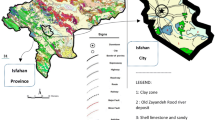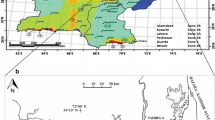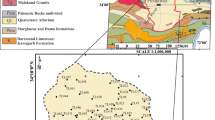Abstract
Local seismic hazard is influenced by the variation of soil parameters which modulates the propagation of seismic waves through soil. Nador is one of the cities in Morocco which is located in a seismically hazardous region. Investigations using ambient noise and SPT-N values were conducted in order to characterize site effects in the urban area of Nador. The predominant period values obtained vary between 0.2 and 0.5 s; whereas shear wave velocity in superficial soft sediment varies from 156 to 212 m/s. The geotechnical conditions are also used to identify the areas of high impedance contrast. It is found that soil with high predominant period undergoes significant amplification. This is observed in the center and near to the shore of Nador city which is underlaying deep soils with clay and sandy clay deposits. The provided results can be useful for seismic risk studies in the region.
Access provided by Autonomous University of Puebla. Download conference paper PDF
Similar content being viewed by others
Keywords
1 Introduction
Study of local seismic hazard is necessary for Earth sciences and urbanism. It is linked to site effects, which can be influenced by the characteristics of soils, possibly resulting in the amplification of seismic waves during earthquakes (Parolai 2012). Many studies use dynamic parameters (predominant period and shear wave velocities) to determine the site response in different areas (Panjamani and Parihar 2011; Pilz et al. 2009; Sil and Sitharam 2013; Lachet et al. 1996).
Nador is located in northeastern Morocco within a geological basin. The geology of the basin is made up of sedimentary deposits of quaternary age with different thicknesses and a volcanic substratum in the Gourougou Mountain (Achalhi 2016). The Moroccan seismic code (Le Reglement Marocain de Construction Parasismique 2002) classifies the region as a high seismicity area, with a PGA value typically of 0.17 g for a return period of 475 years. The main goal of this study is to prepare a map of local seismic hazard for Nador city in terms of predominant period.
2 Data and Methodology
The geotechnical characteristics of the Nador region was obtained from the analysis of fifty three different geotechnical boreholes, providing the lithology and the thickness of shallow layers (Fig. 1).
Shear wave velocity Vs: Seven SPT-N measurements were conducted to determine the N-value (Number of blows), and therefore, we used Eq. (1) given by Hanumantharao and Ramana (2008) to estimate values of shear wave velocities (Vs) in the basin:
where:
Vs = shear wave velocity at a particular depth.
N = SPT-N value at the same depth.
The average shear wave velocity is calculated using the formula (NEHRP 2003):
where:
Vsd = the shear wave velocity,
Vsi = the shear wave velocity of any layer in m/s,
di = the thickness of any layer (between 0 and 30 m).
Geological units in Nador give a first knowledge on the shear wave velocity. Many studies (Pitilakis et al. 2013; Wills and Clahan 2006) and several Building codes (NEHRP, EC8) give correlation between shear wave velocities and geology. The soil in the basin contains soft sediments of fluvial and littoral origin dating from a recent quaternary age down to a depth of 20 m. This formation has Vs values ranging from 150 to 360 m/s.
On the foot of the Gourougou Mountain (Fig. 1a) in the west and north-west of the region, the soil is composed of two layers, including the sedimentary rocks, and from a depth of 6.5 m basaltic volcanic rocks, constituting the basement. The Vs value for the basalts is larger than 760 m/s. The origins and properties of the two layers are different, showing strong impedance contrast between them.
The H/V technique (Nakamura 1989): H/V spectral ratios using ambient vibration data are widely used to characterize site response, particularly in urban areas (Parolai 2012). About 190 background noise recordings were conducted in the urban center and surrounding area of Nador town (Fig. 1b). Ambient vibrations were recorded with a three components material: a CMG-6TD seismometer, a laptop allowing the visualization of the records in the field, and in situ verification. The H/V analysis of the recorded noise was conducted using the SESAME guideline (Bard et al. 2004) and the Geopsy software (Fig. 2). The two types obtained from analysis of H/V spectrum, (a): a clear peak with amplification values superior than 2.5 and (b) a flat curve which there is a non-exhibition of amplification in the measurement’s sites.
3 Results and Discussion
Using the correlation of shear wave velocity with N-values obtained from standard penetration, the mean of shear wave velocity values of soil for the different depths are computed using the formula given by Hanumantharao and Ramana (2008). The mean of superficial Vs values for the different depths is varying from 156 to 212 m/s, and these areas correspond to the central part of the city characterizing the recent quaternary formation. The soil is classified as a very dense soil and soft rocks depending on the classification of Moroccan seismic code (Le Reglement Marocain de Construction Parasismique 2002).
The analysis of H/V curves allow us to estimate the predominant period values in Nador city, the distribution of predominant period values range between 0.2 and 0.5 s (Fig. 3), approximately. The predominant period values describe the surface lithology, which is covered by sediments of loose sands, limestone, and sandy clay materials. Borehole data in soft soils show that the thickness of silt and clay are over 40 m near the shoreline, and decreases as we move away to the west and to the Gourougou Mountain.
High period values are observed on the Eastern part (near to the lagoon). These values are gradually decreasing to the west along the river. The same formation contains a large range of period values, which could be related to the complex geological setting of the area. The results of predominant period obtained in Melilla (Casado et al. 2017) (14 km from Nador) are ranging from 0.12 to 0.5 s which approximately corresponds to the same ranges obtained in this study.
The variation of the observed periods around the Azougagh River (Fig. 3), and in some mountainous regions, is due to several factors such as the composition of soil layers affecting the impedance contrast due to soil density, velocity, and thickness of sediments.
4 Conclusions
This study gives a first quantification of the site response in Nador city. It provides predominant periods and shear wave estimation for the different existing types of soil. These parameters are important to assess the local seismic hazard.
The obtained predominant periods in the urban area range between 0.2 and 0.5 s, with an amplification factor, obtained from H/V curves, ranging from 2.5 to 11.4 (Fig. 3). Even the amplification obtained does not reflect the real amplification that can be exhibited in a seismic action. The values of predominant periods are important in term of spectral coincidences with the building period of the different structures in Nador.
The shallow shear wave velocity in Nador city was calculated through analyzing the standard penetration test for seven measurements. The estimation of shear wave velocity gives information about soil classification. All values in the basin are in range of: 150 m/s < Vs < 360 m/s, which corresponds to a stiff and soft soil, and this classification is very important for engineers in order to make a good building concept.
References
Achalhi, M.: Chronostratigraphie et sédimentologie des bassins néogènes de Boudinar et d’Arbaa Taourirt, Rif oriental, Morocco (2016)
Bard, P.Y., Duval, A.M., Koehler, A., Rao, S.: Guidelines for the implementation of the H/V spectral ratio technique on ambient vibrations measurements. Proc. Interpret. Bull. Earthq. Eng. 169, 1–62 (2004)
Casado, C.L., Henares, J.G., Delgado, J., Pelaez, J.A., Henares, J.: HVSR estimation of site effects in Melilla (Spain) and the damage pattern from the 01/25/2016 Mw 6.3 Alborán Sea earthquake. Nat Hazards. (2017)
Hanumantharao, C., Ramana, G.: Correlation between shear wave velocity and N value for Yamuna sand of Delhi. J. Earth Syst. Sci. 117, S2 (2008)
Lachet, C., Hatzfeld, D., Bard, P.Y., Theodulidis, N., Papaioannou, C., Savvaidis, A.: Site effects and microzonation in the city of Thessaloniki (Greece) comparison of different approaches. Bull. Seismol. Soc. Am. 86, 1692–1703 (1996)
Le Reglement Marocain de Construction Parasismique, Ministère de l’Habitat et de la Politique de la Ville (2002 version 2011)
Nakamura, Y.: A Method for Dynamic Characteristics Estimation of Subsurface Using Microtremors on the Ground Surface. Railwai Technical Researtch Institute Report (1989)
NEHRP: Recommended Provisions for Seismic Regulations for New Buildings and Other Structures (FEMA). National Institute For Building Sciences, Washinton (2003).
Panjamani, A., Parihar, A.: Amplification based on shear wave velocity for seismic zonation: comparison of empirical relations and site response results for shallow engineering bedrock sites. Geomech. Eng. 189–206 (2011)
Parolai, S.: Investigation of Site Response in Urban Areas by Using Earthquake Data and Seismic Noise, pp. 1–34. GFZ, German Research Centre for Geosciences (2012)
Pilz, M., Parolai, S., Felipe, L., Campos, J.: A comparison of site response techniques using earthquake data analysis and ambient seismic noise in large urban areas of Santiago de Chile. Geophys. J. Int. 713–728 (2009)
Pitilakis, K., Riga, E., Anastasiadis, A.: New code site classification, amplification factors and normalized response spectra based on a worldwide ground-motion database. Bull. Earthq. Eng. 925–966 (2013)
Sil, A., Sitharam, T.G.: Dynamic site characterization and correlation of shear wave velocity with standard penetration test ‘N’ values for the city of Agartala, Tripura State, India. Pure Appl. Geophys. (2013)
Wills, C.J., Clahan, K.B.: Developing a map of geologically defined site-condition categories for California. Bull. Seismol. Soc. Am. 1483–1501 (2006)
Author information
Authors and Affiliations
Corresponding author
Editor information
Editors and Affiliations
Rights and permissions
Copyright information
© 2022 The Author(s), under exclusive license to Springer Nature Switzerland AG
About this paper
Cite this paper
Chaaraoui, A., Chourak, M., Peláez, J.A., Cherif, Se. (2022). Seismic Site Response Assessment Using Predominant Periods and Shear Wave Velocity Estimation in Nador (N-E of Morocco). In: Meghraoui, M., et al. Advances in Geophysics, Tectonics and Petroleum Geosciences. CAJG 2019. Advances in Science, Technology & Innovation. Springer, Cham. https://doi.org/10.1007/978-3-030-73026-0_51
Download citation
DOI: https://doi.org/10.1007/978-3-030-73026-0_51
Published:
Publisher Name: Springer, Cham
Print ISBN: 978-3-030-73025-3
Online ISBN: 978-3-030-73026-0
eBook Packages: Earth and Environmental ScienceEarth and Environmental Science (R0)







